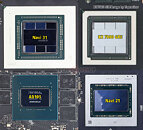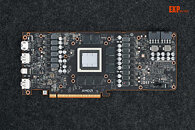- Joined
- Oct 9, 2007
- Messages
- 47,638 (7.44/day)
- Location
- Dublin, Ireland
| System Name | RBMK-1000 |
|---|---|
| Processor | AMD Ryzen 7 5700G |
| Motherboard | Gigabyte B550 AORUS Elite V2 |
| Cooling | DeepCool Gammax L240 V2 |
| Memory | 2x 16GB DDR4-3200 |
| Video Card(s) | Galax RTX 4070 Ti EX |
| Storage | Samsung 990 1TB |
| Display(s) | BenQ 1440p 60 Hz 27-inch |
| Case | Corsair Carbide 100R |
| Audio Device(s) | ASUS SupremeFX S1220A |
| Power Supply | Cooler Master MWE Gold 650W |
| Mouse | ASUS ROG Strix Impact |
| Keyboard | Gamdias Hermes E2 |
| Software | Windows 11 Pro |
The GPU at the heart of the China-exclusive AMD Radeon RX 7900 GRE (Golden Rabbit Edition) sparked much curiosity. It is a physically different GPU from the one found in desktop Radeon RX 7900 XT and RX 7900 XTX graphics cards. AMD wouldn't go through all that effort designing a whole different GPU just for a limited edition graphics card, which means this silicon could find greater use for the company—for example, this could be the package AMD uses for its upcoming mobile RX 7900 series. AMD wouldn't go through all the effort designing a first-party MBA (made by AMD) PCB for the silicon just for the RX 7900 GRE, and so this PCB, with this particular version of the "Navi 31" silicon, could see a wider global launch, probably as the rumored Radeon RX 7800 XT, or something else (although with a different set of specs from the RX 7900 GRE).
We compared the sizes of the new "Navi 31" package found in the RX 7900 GRE, with those of the regular "Navi 31" powering the RX 7900 XT/XTX, the previous-generation "Navi 21" powering the RX 6900 XT, and the NVIDIA AD103 silicon powering the desktop GeForce RTX 4080. There are some interesting findings. The new smaller "Navi 31" package is visibly smaller than the one powering the RX 7900 XT/XTX. It is a square package, compared to the larger rectangular one, and has a significantly thinner metal reinforcement brace. What's interesting is that the 5 nm GCD is still surrounded by six 6 nm MCDs. We don't know if they've disabled two of the six MCDs, or whether they're dummies. AMD uses dummy chiplets as structural reinforcement in some of its EPYC server processors. The dummies spread some of the mounting pressure applied by the IHS or cooling solution, so the logic behind surrounding the GCD with six of these MCDs could be the same.


In the first image above, the four GPU images are to-scale against each other. Expreview is the source for the RX 7900 GRE GPU and PCB images. The Radeon RX 7900 GRE reference PCB physically only has eight memory chips, and no vacant memory pads, unlike the RX 7900 XT reference PCB that has two vacant pads. This points to the possibility that that the smaller "Navi 31" GPU only has pins for a 256-bit wide memory bus. Besides fewer memory pins, the lower pin-count of the package could be attributed to fewer power pins. Back to the size comparison, and we see that the smaller "Navi 31" package is actually a slightly larger than the "Navi 21" GPU powering the previous-generation Radeon RX 6800 series and RX 6900 series. What's interesting is that both the new "Navi 31" package, and the "Navi 21," are smaller than the NVIDIA AD103 GPU that powers the desktop RTX 4080.
View at TechPowerUp Main Site
We compared the sizes of the new "Navi 31" package found in the RX 7900 GRE, with those of the regular "Navi 31" powering the RX 7900 XT/XTX, the previous-generation "Navi 21" powering the RX 6900 XT, and the NVIDIA AD103 silicon powering the desktop GeForce RTX 4080. There are some interesting findings. The new smaller "Navi 31" package is visibly smaller than the one powering the RX 7900 XT/XTX. It is a square package, compared to the larger rectangular one, and has a significantly thinner metal reinforcement brace. What's interesting is that the 5 nm GCD is still surrounded by six 6 nm MCDs. We don't know if they've disabled two of the six MCDs, or whether they're dummies. AMD uses dummy chiplets as structural reinforcement in some of its EPYC server processors. The dummies spread some of the mounting pressure applied by the IHS or cooling solution, so the logic behind surrounding the GCD with six of these MCDs could be the same.


In the first image above, the four GPU images are to-scale against each other. Expreview is the source for the RX 7900 GRE GPU and PCB images. The Radeon RX 7900 GRE reference PCB physically only has eight memory chips, and no vacant memory pads, unlike the RX 7900 XT reference PCB that has two vacant pads. This points to the possibility that that the smaller "Navi 31" GPU only has pins for a 256-bit wide memory bus. Besides fewer memory pins, the lower pin-count of the package could be attributed to fewer power pins. Back to the size comparison, and we see that the smaller "Navi 31" package is actually a slightly larger than the "Navi 21" GPU powering the previous-generation Radeon RX 6800 series and RX 6900 series. What's interesting is that both the new "Navi 31" package, and the "Navi 21," are smaller than the NVIDIA AD103 GPU that powers the desktop RTX 4080.
View at TechPowerUp Main Site


